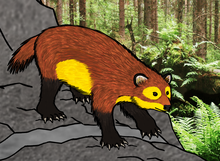| Ballusia Temporal range:
| |
|---|---|

| |
| Life restoration of B. orientalis | |
| Scientific classification | |
| Domain: | Eukaryota |
| Kingdom: | Animalia |
| Phylum: | Chordata |
| Class: | Mammalia |
| Order: | Carnivora |
| Family: | Ursidae |
| Genus: | †Ballusia Ginsburg & Morales, 1998 |
| Type species | |
| †Ballusia elmensis | |
| Species | |
| |
Ballusia is a genus of small bear from the Early Miocene epoch, about 20.5-18 million years ago. Fossil remains attributed to the genus have been uncovered in Europe (Poland) and Asia (Russia, Mongolia, China).[1][2] The genus Ballusia was established in 1998 on the basis of different fossils originally classified as various species of the genera Ursavus and Hemicyon,[1] with B. elmensis as the type species. The exact relationship of Ballusia to "true" bears (subfamily Ursinae, which include modern bears) are not yet fully understood: many palaeontologists have classified it as a primitive member of Ursinae, but its known skeletal elements have some features in common with the extinct bear subfamily Hemicyoninae. Because of this, some researchers refer Ballusia as "Ursidae incertae sedis". Ginsburg and Morales regarded B. elmenensis as ancestral to Ursavus,[1] as did Marciszak and Lipecki, even though the temporal range of the two genera seems to have overlapped.[3] [4]
- ^ a b c Ginsburg, L; Morales, G (1998). "Hemicyoninae (Ursidae, Carnivora, Mammalia) and the related taxa from Early and Middle Miocene of Western Europe". Annales de Paléontologie. 84 (1): 71–123. doi:10.1016/S0753-3969(98)80003-7.
- ^ Baryshnikov, G.F.; Lavrov, A.V. (2015). "Early Miocene bear Ballusia (Carnivora, Ursidae) from the locality Khirgis-Nur-I in Mongolia". Proceedings of the Zoological Institute RAS. 319 (3): 341–350. doi:10.31610/trudyzin/2015.319.3.341. S2CID 247552126.
- ^ Marciszak, A; Lipecki, P (2020). "The history of bears (Ursidae, Carnivora, Mammalia) from Silesia (southern Poland) and the neighbouring areas" (PDF). Geological Quarterly. 64 (4): 876–897. doi:10.7306/gq.1565. S2CID 228913263.
- ^ Qui, Z-X; Deng, T; Wang, B-Y. (2014). "A Late Miocene Ursavus skull from Guanghe, Gansu, China" (PDF). Vertebrata PalAsiatica. 52 (3): 265–302.